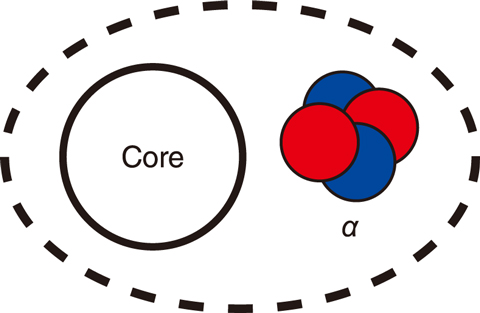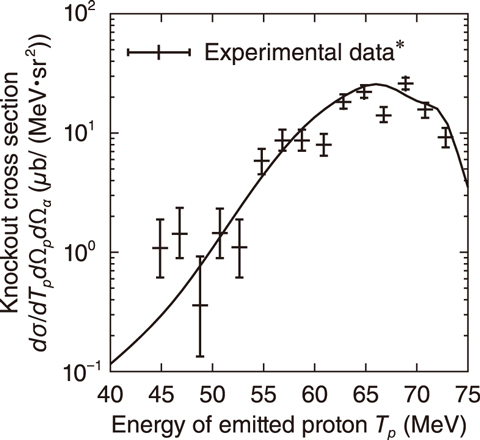
Fig.3-13 Cluster structure

Fig.3-14 The proton (•) induced an α-knockout reaction from a target nucleus

Fig.3-15 20Ne(p,pα)16O reaction cross section
Nuclei, which consist of only two types of particles, protons and neutrons (called nucleons), are known to exhibit a wide variety of aspects, in contrast with their simple composition. One of the most interesting nuclear structures is the cluster structure.
In this structure, nucleons are divided into two or more clusters and the nucleus forms an unusual shape instead of a simple sphere. In particular, the α-cluster structure, in which the nucleus is divided into an α-particle and a core nucleus and shown in Fig.3-13, has been commonly observed, as the α-particle is very stable and strongly bound. The cluster states are mainly expected to exist in light nuclei with the same number of protons and neutrons as α-particles (e.g., 8Be, 12C, 16O, 20Ne, 24Mg), and both experimental and theoretical studies are ongoing.
To investigate the cluster structure and its probability, the proton-induced knockout reaction was studied. In this reaction, shown in Fig.3-14 a proton is bombarded into a target nucleus and an α-particle is knocked out. The knockout reaction is a method of knocking out an α-particle from the nucleus by bombarding it with protons with relatively high incident energy (i.e., several hundred MeV). One advantage of this method is that the reaction probability (i.e., reaction cross section) and the α-cluster state probability have a one-to-one correspondence, since the transition of the bound state to the scattering state of the α-particle is in a one-step process at such high incident energy.
Since both α and 16O nuclei have a double-closed-shell nature (i.e., a nuclear magic number), 20Ne is a promising nucleus for α+16O cluster structure. The α-knockout experiment from 20Ne was performed in 1984; according to the results of the analysis at that time, about 60% of the α−16O cluster component probability was expected in the 20Ne ground state. However, this number was about 2–3 times greater than the predictions of structural theory, and has yet to be adequately addressed.
Using a structural theory based on nucleon degrees of freedom and reaction theory calculations with the latest interactions between scattering particles, this work demonstrated that the proposed theoretical calculation method of the knockout reaction cross section reproduces experimental data without any inconsistencies, as detailed in Fig.3-15. This work therefore represents the first quantitative reproduction of the α-knockout experiment with the reaction theory, and provides an important result showing that this method can quantitatively investigate cluster states.
(Kazuki Yoshida)
* Carey, T. A. et al., Alpha-Particle Spectroscopic Strengths Using the (p, pα) Reaction at 101.5 MeV, Physical Review C, vol.29, issue 4, 1984, p.1273–1288.
<Previous: 3-5 | Next: 4 Nuclear Science and Engineering Research>